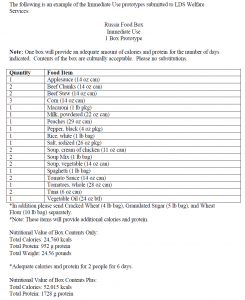Serena Arave, Shenai Fisher, Lori MacArthur, Cary Rogers and Dr. Diana McGuire, Food Science and Nutrition
Summary
In conjunction with LDS Welfare Services and the Brigham Young University Food Science and Nutrition Department the International Food Relief Committee met the project objective to develop food box prototypes that are culturally and nutritionally appropriate for global emergency or disaster situations. The final prototypes were given to LDS Welfare Services to be used when sending emergency food relief to other countries.
In the past LDS Welfare Service had experiences where the food sent was not always appropriate culturally or nutritionally. Through our research we would solve this problem by determining the foods that are acceptable for cultural and religious reasons and would meet minimum nutritional requirements.
After researching food patterns throughout the world we have completed food box prototypes for the following countries: Argentina, Bolivia, Brazil, Chile, Ghana, India, Mexico, Peru, Russia, and Ukraine. Other countries are also nearing completion. The prototypes included background information on the country to help those involved with the food box packaging become more familiar with the country. In addition to this the prototype included three possible food lists to be sent in emergency situations.
The first, the Immediate Use Food Box, included only those foods immediately available at the Bishop’s Storehouse in Salt Lake City, Utah. In the event of a disaster many times only those foods available in the first 48 hours could be sent. The second, the Recommended Use Food Box, included additional items that the Church can obtain within a few days to a week. This box could be sent in situations where the need is not quite as urgent, or if it is a second shipment. This can also be a reference prototype to improve the type of food aid being offered. The final prototype, the Ideal Use Food Box, includes many items available from the first two prototypes. In addition to this it includes staple food items native to the specified country. These are items which the Church may look into purchasing in the future as the humanitarian aid programs continue to expand. The Ideal Use Box will give more optimal care to those receiving aid.
After developing the prototype drafts we went to the Lindon Cannery and placed the recommended foods in the box provided by LDS Welfare Services. The food placement was then diagramed and included with the background information and prototypes. The nutritional value of the food was determined and met our minimum requirements for 2,000 kilocalories and 12% protein per person per day. This would provide adequate nourishment for a short-term basis to those receiving food aid.

Note: The nutritional adequacy for a specified number of days is not indicated for additional contents. Because of the package sizes the items will not likely be consumed in the same time frame as the box contents. The additional items may, however, add one or two additional days worth of calories and protein to the food items in the box.
